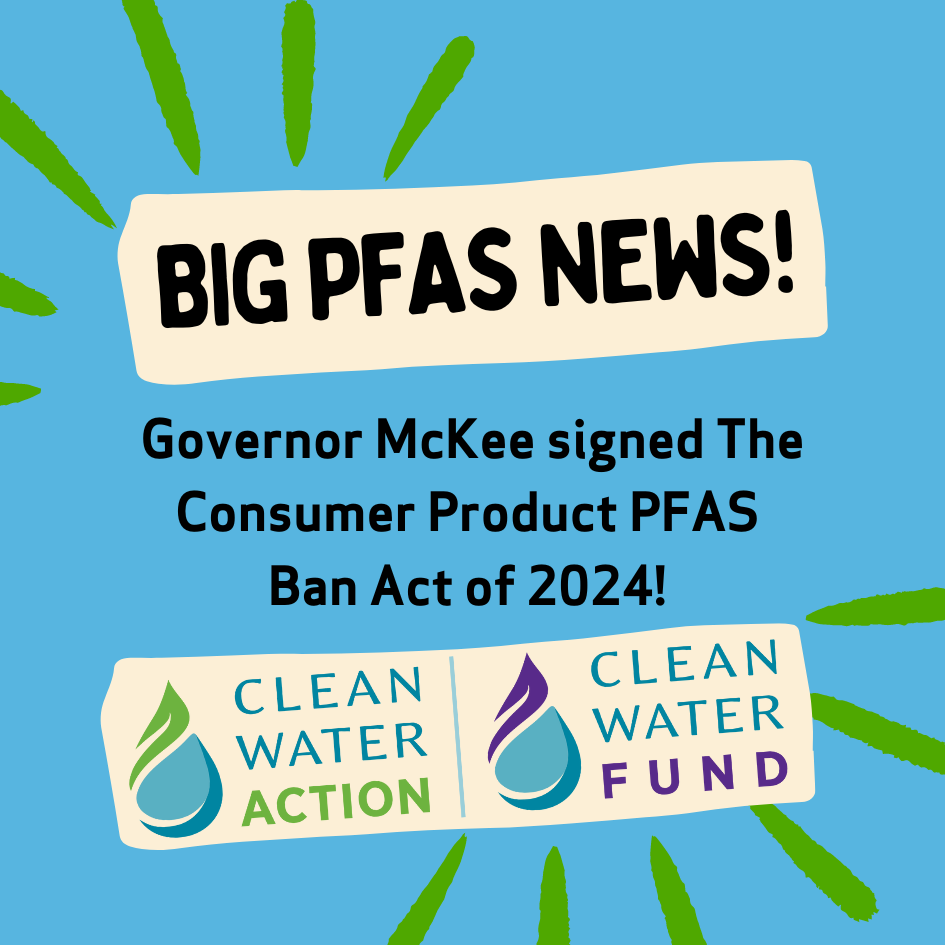
What are PFAS?
PFAS are a class of human-made chemicals which includes Per- and Polyfluoroalkyl substances. These chemicals are very long-loved, which means that they remain in the environment and in humans and wildlife for a very long time. Two of these chemicals, PFOA and PFOS are relatively well known, and manufacturers have voluntarily stopped producing them. However, PFOA and PFAS continue to be detected at contaminated sites, in water, and in our bodies.
-
PFOA is found in the blood of most Americans at low levels.
-
PFAS pollution has been documented at 94 sites in 22 states (including industrial plants, military bases, airports and fire training sites) and in the tap water of up to 16 million people in 33 states.
There may be as many as 4,000 other PFAS chemicals, and we know less about where they are made, what they are used for, water contamination or other presence in the environment, their health effects, and in most cases how to detect them.
PFAS in Consumer Products
Use in fire fighting foam is common but that’s NOT the only use. They have been widely used since the 1950s in nonstick cookware, water-repellent clothing, stain resistant fabrics and carpets, some cosmetics, products that resist grease, water, and oil, and food packaging (like pizza boxes and microwave popcorn bags).
What are their health effects?
-
PFAS are concerning because they are very persistent, don’t break down in the environment or the human body and can accumulate over time. Children are particularly at risk.
-
Earlier studies have shown that PFOA causes cancer, PFOS disrupts thyroid hormones, and both can affect the immune system and reduce infant birth weights.
-
A recent study released by the US Agency for Toxic Substances & Disease Registry (ATSDR) found that PFAS were more harmful than previously thought and that “safe levels” were 10 times less than previously thought. Potential health effects identified in this study include liver damage, increases in cholesterol, increased risk of thyroid disease, asthma, and infertility, decreased response to vaccines, riskier pregnancies, and decreases in birth weight.
How does contamination occur and how are people exposed?
-
Firefighting foam can contaminate soil and groundwater.
-
Waste from PFAS manufacturing or from industrial facilities using PFAS or making products containing them can also contaminate soil and water.
-
Food packaging containing PFAS can potentially transmit PFAS to the food in the packaging, which we eat.
-
Use of other products like carpeting, clothing, packaging materials containing PFAS, personal care products, and others can expose our skin to the chemicals.
-
Working at a facility that produces PFAS or that makes products using these chemicals can also be a source of exposure.
What do we want?
-
Right to Know: We need to know where these chemicals are made and used and in what products. We also need to identify how they are getting into the environment and to stop that contamination.
-
Innovation in Science and Tools: We need new laboratory methods to find these chemicals in water. We need to invest in innovations in drinking water treatment and clean-up technology. We need better information on effects on our health, on wildlife, and on overall environmental quality.
-
Hold Polluters Accountable: Producers of these chemicals need to be accountable for contamination, and for continuing to make and use these chemicals while withholding evidence of health risks. Costs of clean up should not be paid by taxpayers and consumers, but by those responsible for the contamination.
What can be done?
State and federal government can and should act by:
-
Identifying and disclosing where PFAS are manufactured, where releases to the environment are occurring, and their use in food packaging and other consumer items
-
Increasing research into human health risks
-
Developing laboratory methods to test for PFAS in drinking water, wastewater, and at toxic sites
-
Increasing investment in research on treatment to remove PFAS in drinking water and at toxic sites
-
Reforming fire fighting foam requirements, including eliminating requirements to use PFAS in training exercises
-
Using all available authority to control releases into the environment
-
Increasing drinking water monitoring
Some states are taking the lead in addressing PFAS chemicals. Examples include:
-
Washington state has banned PFAS in firefighting foam and will ban it in food packaging starting in 2022 if the state finds there are alternatives available. Washington is also conducting an assessment of alternative chemicals.
-
California is considering a bill to list ingredients in food packaging so consumers know if chemicals like PFAS are used
-
New Jersey has set drinking water limits for several PFAS chemicals. Other states are considering similar action.
What is Clean Water Action doing?
-
Educating policymakers and the public about the risks of PFAS chemicals, how they are used, solutions, and the need to hold polluters accountable.
-
Focusing on drinking water impacts and identifying research needs, impacts on public water systems, and Safe Drinking Water Act responses to protect public health.
-
Identifying ways to stop releases including stopping the use of these chemicals, through pollution control programs under the Clean Water Act, and using other programs.
-
Working with impacted communities - those with contaminated soil, wells or water sources - to support their efforts to hold polluters accountable, to get water treatment or new water sources, health monitoring, and clean up of contaminated sites.
-
Working on state regulation and legislation to tell consumers when PFAS is in food packaging and consumer products, to curb their use, stop contamination of water, and hold polluters accountable.
-
Supporting Safe Drinking Water Act programs to monitor PFAS in drinking water, develop accessible testing and treatment technologies, identify health protective drinking water standards, and educate consumers about what they can do to protect themselves and their families from PFAS in drinking water.